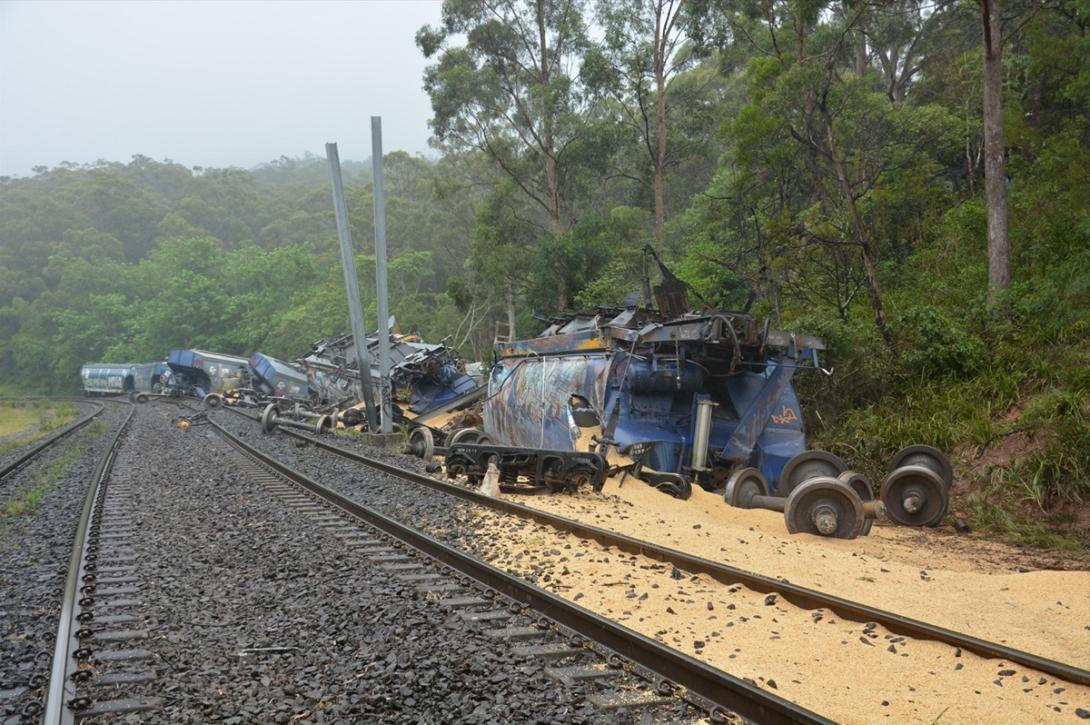
A transport safety investigation has concluded ineffective braking, caused by several factors, contributed to the runaway and subsequent high-speed derailment of almost 40 loaded grain wagons south-west of Wollongong.
A final report, released today, notes a range of factors relating to weight, braking equipment, track conditions and operational procedures led to the 2020 incident.
Shortly before dawn on 15 December 2020, the crew of a Qube-operated grain train, consisting of two locomotives, 40 loaded wagons and one empty wagon, lost control on the descent into Unanderra on the Moss Vale to Unanderra rail line.
During the runaway, the train reached 100 km/h on a 30 km/h section of steep, winding track.
The consist subsequently separated at two points, and 39 of the trailing wagons derailed and were destroyed, causing substantial damage to track infrastructure.
Fortunately, the locomotives and first two wagons remained on the track, and the crew – the driver and driver’s assistant – were able to avoid physical injury, stopping the train towards the bottom of the embankment.
A final report from the Office of Transport Safety Investigations (OTSI), which conducts rail investigations in New South Wales on behalf of the Australian Transport Safety Bureau, notes 13 findings – either contributing factors, or factors which increased risk in the accident.
“Among the findings, the investigation identified several factors led to the train’s braking being ineffective, contributing to the runaway,” OTSI’s Acting Chief Investigator Jim Modrouvanos said.
“It was likely that several individual wagons were over their allowable weight limit, and the train as a whole was near, but likely not over its own maximum allowable tonnage,” he noted.
“In addition, variability in the braking capability between wagons likely reduced the braking effort on some wagons during the steep descent.
“Low track adhesion caused by wet rail and track contaminant also affected train handling and locomotive dynamic braking.”
In addition to vehicle and environmental factors, the investigation also examined the actions of the driver during the runaway sequence.
It found some of the driver’s decisions on the morning of the accident were likely affected by fatigue, but also that Qube’s relevant operational procedure did not account for locomotive configurations that maintained locomotive dynamic braking during emergency applications.
“This increased the risk of the train driver not using the emergency brake during a runaway, due to a mistaken understanding that the dynamic brake would cut out if emergency braking was applied,” Mr Modrouvanos said.
In response to the identification of this safety factor during the investigation, OTSI released a Safety Advisory Notice in June 2022, urging rail operators to ensure they and their drivers understand the operation of their locomotives.
The final report further encourages this action, and also for operators to ensure their trains have sufficient braking, are loaded within safe load limits, and are operated in accordance with their procedures.
“Qube and other affected rollingstock operators have subsequently taken action to review their locomotive configurations, and ensure their drivers have a clear understanding of the braking systems and can competently operate them in an emergency and in higher risk environments such as steep descents,” Mr Modrouvanos reported.
“This was on top of a number of safety actions that have been taken by Qube, Sydney Trains, and the Australian Rail Track Corporation, in response to this accident, and these are detailed in the final report.”
Read the report: Derailment involving loaded grain train 3966, Dombarton, New South Wales, on 15 December 2020


